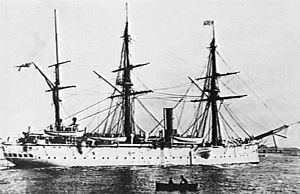Name HMS Cordelia Fate Sold 1904 Displacement 2,380 tons Construction started 17 July 1879 Length 69 m Draft 5.8 m | Laid down 17 July 1879 Beam 44 ft (13 m) Launched 25 October 1881 Weight 2,418 tons Builder HMNB Portsmouth | |
 | ||
HMS Cordelia was an Comus-class corvette of the Royal Navy, built at the Portsmouth Dockyard and launched on 25 October 1881.
She commenced service on the China Station before being transferred to the Australia Station arriving in April 1890. On 29 June 1891, during gun practice while on a cruise from Fiji to Noumea, a gun burst killing five, mortally wounded another and injuring thirteen crew. She left the Australia Station in late 1891.
She was sold on 5 July 1904 for breaking up. The mast at HMS Ganges was the foremast of Cordelia.
Design
Planning for six metal-hulled corvettes began in 1876; these became the Comus-class corvettes and were designed for long voyages away from coaling stations. Given a metal hull, its frame was composed of iron or steel. Its hull had copper sheathing over timber beneath the waterline, but that timber simply served to separate the iron hull from the copper sheathing so as to prevent electrolytic corrosion. The timber extended to the upper deck; it was in two layers from the keel to 3 ft (.9 m) above the water line, and one layer above.
It was fitted with 3-cylinder compound engines with one high-pressure cylinder of 46 inches (1,200 mm) diameter being flanked by two low-pressure cylinders of 64 inches (1,600 mm) diameter. The bow above the waterline was nearly straight, in contrast to that of wooden sailing ships. It had stern galleries, similar to older frigates, but the ports were false, and there were no quarter galleries. Boats were carried both amidships and at the stern. Cordelia flew a barque or ship rig of sail on three masts, including studding sails on fore and mainmasts.
Between its two complete decks was the open quarterdeck, on which the battery was located. Under the lower deck were spaces for water, provisions, coal, and magazines for shell and powder. Amidships were the engine and boiler rooms. These were covered by an armoured deck, 1.5 inches (38 mm) thick and approximately 100 ft (30 m) long. This armour was about 3 ft (90 cm) below the lower deck, and the space between could be used for additional coal bunkerage. The machinery spaces were flanked by coal bunkers, affording the machinery and magazines some protection from the sides. The lower deck was used for berthing of the ship's company; officers aft, warrant and petty officers forward, and ratings amidships, as was traditional. The tops of the coal bunkers, which projected above deck level, were used for seating at the mess tables. The living spaces were well-ventilated and an improvement over prior vessels.
